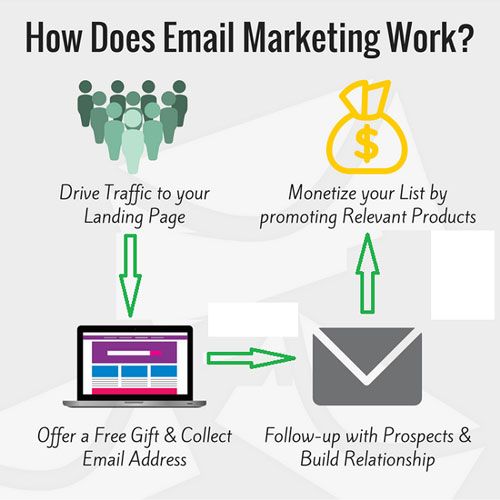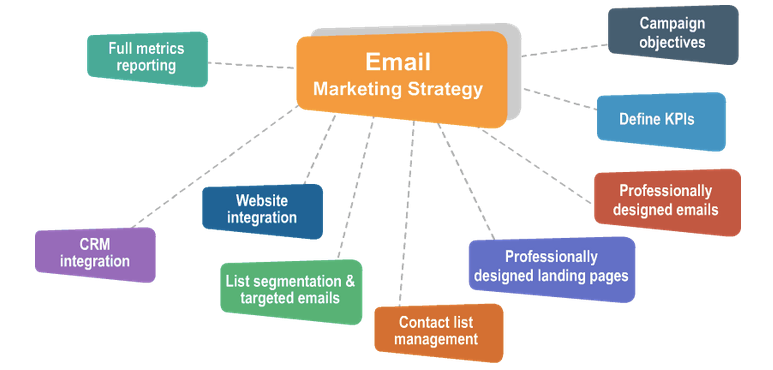A vital tool for connecting with customers, fostering connections, and boosting sales is email marketing. Businesses can target particular audience segments and personalize their message using this economical and effective method of reaching a big audience.
What is Email Marketing?
Email marketing is a form of direct marketing that uses email to promote products or services. It involves sending commercial messages to a targeted group of people who have opted-in to receive emails from the business. Email marketing can be used to promote a range of activities, such as sales, events, news, and updates.

Benefits of Email Marketing

Email marketing has several benefits, including:
- Cost-effective: Email marketing is cost-effective compared to traditional marketing channels such as print, TV, or radio ads.
- Personalization: Email marketing allows businesses to personalize their messages and target specific segments of their audience based on their preferences, behavior, and demographics.
- Measurable: Email marketing provides businesses with quantifiable results such as open rates, click-through rates, and conversion rates, which helps them to refine and improve their campaigns.
- Reach: Email marketing allows businesses to reach a large audience quickly and efficiently.
- Automation: Email marketing can be automated, which saves time and resources and allows businesses to send personalized messages at the right time.
What are the strategies and Tools used in Email Marketing?
There are several strategies and tools used in email marketing to make it a successful and effective channel for businesses. Some of the most significant ones are listed below:

- Email List Building: The first step in email marketing is to build a high-quality email list. This involves collecting email addresses from customers, prospects, and other people who have given permission to receive emails from your business. Some effective ways to build an email list include offering a lead magnet, hosting a giveaway, and using social media to promote your email list.
- Personalization: Personalization is a key strategy in email marketing. It involves tailoring your emails to the interests, preferences, and behaviors of your subscribers. By using data and analytics, businesses can segment their email lists and send personalized messages that resonate with each segment.
- Email Design: The design of your email is critical to its success. It should be visually appealing, easy to read, and optimized for mobile devices. You can use email templates or custom designs to create professional-looking emails that reflect your brand identity.
- Subject Line Optimization: The subject line is the first thing your subscribers see in their inbox, and it can make or break your email’s success. An effective subject line should be clear, concise, and attention-grabbing. You can use A/B testing to test different subject lines and see which ones perform best.
- Call-to-Action: A clear call-to-action (CTA) is an essential part of every email. It tells your subscribers what you want them to do, such as making a purchase, signing up for a webinar, or downloading a whitepaper. Your CTA should be prominent and easy to click, and it should be tailored to the goal of each email.
- Email Marketing Automation: Email marketing automation involves using software to automate your email campaigns. This can save you time and resources, while also allowing you to send timely and relevant messages to your subscribers. You can use automation to send welcome emails, abandoned cart reminders, and other triggered emails.
- Email Analytics: Email analytics allows you to track and measure the success of your email campaigns. Metrics like open rates, click-through rates, conversion rates, and income earned can all be tracked. This data can help you refine your email marketing strategy and improve your results over time.
The following are some of the most well-liked email marketing tools:
- Mailchimp: Mailchimp is a popular email marketing platform that allows businesses to create, send, and track email campaigns. A variety of features are available, such as email templates, automation, and analytics.
- Constant Contact: Constant Contact is an email marketing platform that offers a range of tools for email marketing, including email templates, list building, and analytics.
- HubSpot: HubSpot is a marketing automation platform that includes email marketing tools, as well as other features such as CRM, social media, and analytics.
- ConvertKit: For bloggers and content producers, ConvertKit is an email marketing tool. There are options like segmentation, automation, and landing pages available.
Best Practices for Email Marketing
To make the most out of email marketing, it is important to follow some best practices, such as:
- Segment your audience: Segment your audience based on their behavior, preferences, and demographics. This will allow you to send personalized messages that resonate with your audience.
- Use a clear subject line: Use a clear and concise subject line that describes the content of your email and entices the recipient to open it.
- Use a recognizable sender name: Use a recognizable sender name, such as your brand name or the name of a person in your organization, to increase the chances of your email being opened.
- Use a responsive design: Use a responsive design that adjusts to the size of the screen and device of your recipient.
- Call to action: Include a clear and prominent call-to-action (CTA) that encourages the recipient to take action, such as clicking a link or making a purchase.
Successful Email Marketing Campaigns
Successful email marketing initiatives have many examples. Here are a few:
- Airbnb: Airbnb sends personalized emails to its users based on their search history, preferences, and behavior. This allows them to send highly relevant and personalized messages, which increases engagement and conversions.
- Dropbox: Dropbox sends a welcome email to new users with a clear CTA and a step-by-step guide on using their service. This helps new users get started and increases the chances of them becoming long-term customers.
- Amazon: Amazon sends personalized recommendations to its users based on their browsing and purchase history. This helps them to upsell and cross-sell products and increase sales.
Conclusion
Email marketing is a powerful tool that can help businesses connect with their customers, build relationships, and drive sales. It is a cost-effective and efficient way to reach a large audience, and it allows businesses to personalize the message and target specific segments of their audience. By following best practices and learning from successful email marketing campaigns, businesses can create effective email campaigns that resonate with their audience and achieve their goals.

